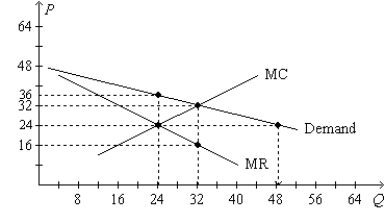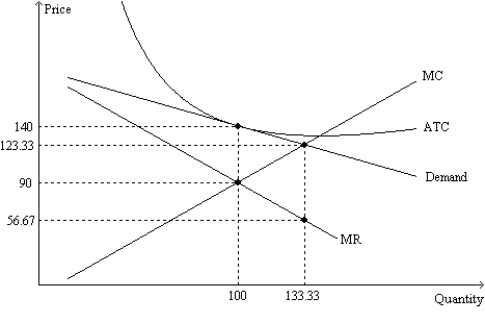Correct Answer

verified
Correct Answer
verified
Multiple Choice
Table 16-2
The following table shows the total output produced by the top six firms as well as the total industry output for each industry.  -Refer to Table 16-2. What is the concentration ratio for Industry J?
-Refer to Table 16-2. What is the concentration ratio for Industry J?
A) about 14%
B) about 48%
C) about 74%
D) about 80%
Correct Answer

verified
Correct Answer
verified
Multiple Choice
Which of the following statements is not correct?
A) Firms in monopolistic competition and monopoly can earn economic profits in the short run.
B) Firms in monopolistic competition and perfect competition produce the welfare-maximizing level of output.
C) Monopolistically competitive firms price above marginal cost, whereas competitive firms price at marginal cost.
D) Firms wishing to enter a monopolistically competitive market can do so freely, whereas firms wishing to enter a monopoly market will face barriers.
Correct Answer

verified
Correct Answer
verified
Multiple Choice
Figure 16-2. The figure is drawn for a monopolistically competitive firm.  -Refer to Figure 16-2. Suppose you were to add the ATC curve to the diagram to show the firm in a situation of long-run equilibrium. You would draw the ATC curve
-Refer to Figure 16-2. Suppose you were to add the ATC curve to the diagram to show the firm in a situation of long-run equilibrium. You would draw the ATC curve
A) with its minimum at the point (Q = 24, P = $36) .
B) with its minimum at the point (Q = 24, P = $24) .
C) tangent to the demand curve at the point (Q = 24, P = $36) .
D) tangent to the demand curve at the point (Q = 32, P = $32) .
Correct Answer

verified
Correct Answer
verified
Multiple Choice
Most businesses advertise their products and services. Some business use SPAM emails to advertise because the cost of a mass e-mail is close to zero. Other business spend millions of dollars to advertise in a 30-second spot during the Super Bowl. Having observed this real world data, economists argue that the amount of money that a business spends on advertising is a proxy for a good or service's
A) size.
B) quality.
C) newness.
D) cost of production.
Correct Answer

verified
Correct Answer
verified
Multiple Choice
Which of the following statements is correct?
A) Firms in monopolistic competition and monopoly can earn economic profits in both the short run and the long run.
B) Both perfectly competitive and monopolistically competitive firms are price takers.
C) Both a monopolistically competitive industry and a monopoly are characterized by a very small number of (or one) firm(s) .
D) Firms can easily enter a perfectly competitive or monopolistically competitive industry.
Correct Answer

verified
Correct Answer
verified
Multiple Choice
One characteristic of an oligopoly market structure is:
A) firms in the industry are typically characterized by very diverse product lines.
B) firms in the industry have some degree of market power.
C) products typically sell at a price equal to their marginal cost of production.
D) the actions of one seller have no impact on the profitability of other sellers.
Correct Answer

verified
Correct Answer
verified
Multiple Choice
The relationship between advertising and product differentiation is
A) positive; the more differentiated the product, the more a firm is likely to spend on advertising.
B) negative; the more differentiated the product, the less a firm is likely to spend on advertising.
C) zero; there is no relationship between product differentiation and advertising.
D) irrelevant; firms with differentiated products do not need to advertise.
Correct Answer

verified
Correct Answer
verified
True/False
Product differentiation always leads to some measure of market power.
Correct Answer

verified
Correct Answer
verified
Multiple Choice
The entry of new firms into a monopolistically competitive market is accompanied by
A) both positive and negative externalities.
B) only positive externalities.
C) only negative externalities.
D) only private profit opportunities (no externalities) .
Correct Answer

verified
Correct Answer
verified
True/False
A profit-maximizing firm in a monopolistically competitive market charges a price equal to marginal cost.
Correct Answer

verified
Correct Answer
verified
Multiple Choice
A concentration ratio
A) measures the percentage of total output supplied by the four largest firms in the industry.
B) reflects the level of competition in an industry.
C) is related to the control that each firm has over price.
D) All of the above are correct.
Correct Answer

verified
Correct Answer
verified
Multiple Choice
When a market is monopolistically competitive, the typical firm in the market can earn
A) losses in the short run and profits in the long run.
B) profits in the short run and the long run.
C) losses in the short run and zero profit in the long run.
D) zero profit in the short run and losses in the long run.
Correct Answer

verified
Correct Answer
verified
Multiple Choice
Critics of advertising argue that advertising
A) creates desires that otherwise might not exist.
B) enhances competition.
C) benefits television viewers who enjoy TV commercials.
D) All of the above are correct.
Correct Answer

verified
Correct Answer
verified
Multiple Choice
Monopolistic competition is an
A) efficient market structure because long-run profits are zero.
B) efficient market structure because each firm produces at its efficient scale.
C) inefficient market structure because there is deadweight loss.
D) Both a and b are correct.
Correct Answer

verified
Correct Answer
verified
True/False
Brand names are rarely used to convey information about product quality.
Correct Answer

verified
Correct Answer
verified
Multiple Choice
Adibok knows that it produces and sells high quality athletic shoes. Wurkout knows that it produces and sells low quality athletic shoes. According to the signaling theory of advertising,
A) both Adibok and Wurkout have incentives to spend large amounts of money on advertising for their athletic shoes.
B) Adibok has an incentive to spend a large amount of money on advertising for its athletic shoes, but Wurkout does not.
C) Wurkout has an incentive to spend a large amount of money on advertising for its athletic shoes, but Adibok does not.
D) neither Adibok nor Wurkout has an incentive to spend a large amount of money on advertising for their athletic shoes.
Correct Answer

verified
Correct Answer
verified
Multiple Choice
In the long run,
A) monopolistically competitive firms earn a higher profit than perfectly competitive firms because monopolistically competitive firms have some monopoly power.
B) monopolistically competitive firms produce a higher output than perfectly competitive firms because competition drives the perfectly competitive firms' output down.
C) both monopolistically competitive and perfectly competitive firms produce where P = MC.
D) both monopolistically competitive and perfectly competitive firms produce where P = ATC.
Correct Answer

verified
Correct Answer
verified
Multiple Choice
Which of the following is not an argument made by critics of advertising?
A) Advertising manipulates people's tastes.
B) Advertising impedes competition.
C) Advertising promotes economies of scale.
D) Advertising increases the perception of product differentiation.
Correct Answer

verified
Correct Answer
verified
Multiple Choice
Figure 16-9
The figure is drawn for a monopolistically-competitive firm.  -Refer to Figure 16-9. For this firm, the long-run equilibrium quantity of output is
-Refer to Figure 16-9. For this firm, the long-run equilibrium quantity of output is
A) 100 and the long-run equilibrium price is $90.
B) 100 and the long-run equilibrium price is $140.
C) 133.33 and the long-run equilibrium price is $56.67.
D) 133.33 and the long-run equilibrium price is $123.33.
Correct Answer

verified
Correct Answer
verified
Showing 241 - 260 of 580
Related Exams